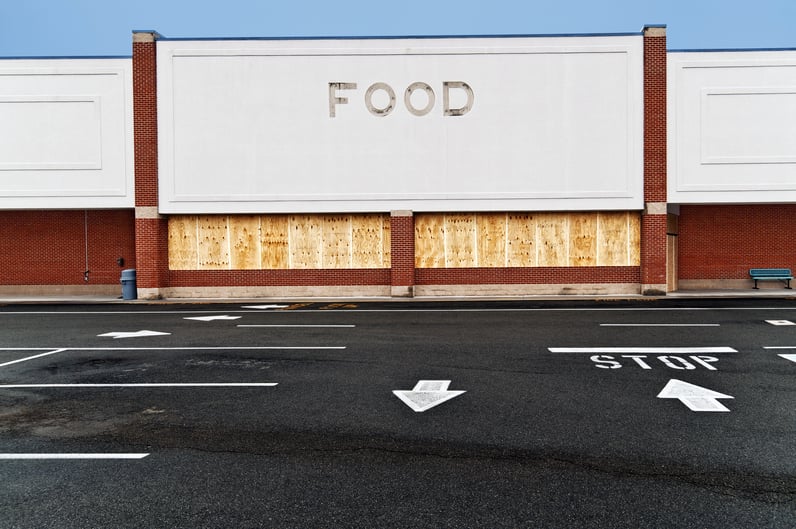
Whether you’re launching a new retail or restaurant business or expanding your concept to open new sites, you know already that the location you choose is key to your success. But consider this stark fact: choosing the wrong location could lead to lost revenue that you never recoup and have a ripple effect across your chain—even if you have an attractive concept and a respected, established brand.
What exactly is a “bad” location?
Most retailers and brokers know the traits of a bad site: poor ingress/egress, low visibility, and an area that makes customers feel unsafe, for example. Ultimately, a bad location is any site that causes you to leave potential revenue on the table. Yes, that means even a site that is profitable could be considered bad by this definition, but the point is this: your goal should be to maximize the performance of each and every location you have. Your site plays a critical part in that.
A bad location leads to underperformance as well as many other unexpected expenses. Here are some of the costs that can arise when you pick the wrong location:
- Lower sales – The most obvious cost of a bad location is lost opportunity for revenue. Let’s assume an unwise location decision leads you to forgo $5,000 per week in revenue. That’s $260,000 in lost revenue in one year and just over $1,000,000 over four years. Even if you have other successful locations, the bleeding from this one location could put your entire portfolio of business in jeopardy.
- Slow ramp-up time – A poor location might take a long time to build a loyal following, with customers taking a while to become aware that you exist. Because your ideal customers don’t know about you, they’re not going to try your business (we call these trials) and are certainly unlikely to become regular, repeat shoppers (we call these adoptions). Delayed revenues caused by low trials and adoptions will hurt your long-term profitability and could cause damage that can’t be undone.
- Additional advertising – Trials and adoptions can be boosted by buzz generated among those who do know about you, social media, and of course, advertising. However, while getting your name out there is important, a bad location might negate even the best marketing and advertising campaign—and additional money spent towards more advertising may just be wasted effort. A customer might hear about you on TV or the radio, but if they’re not frequently reminded that you’re out there (due to a location they never notice or don’t want to visit), they might not bother to make the effort.
- Brand damage – One bad location can hurt your profitability across locations, negatively impact what customers think of you, and erode market share, which can hurt all of your stores in a market. Not to mention, if your site selection methodology is bad, you’re far more likely to make this mistake over and over, which will ultimately damage your brand.
Make retail site selection your highest priority.
When opening a new store or restaurant, finding the right location should be your #1 priority, not your #5 priority. As you do your location analysis, be sure to evaluate these factors as well:
- Changing demographics – Who lives in the area today? What is happening in the area that might cause a significant change in demographics (such as a neighborhood historically filled with retirees now seeing a lot of young families moving in, or an area that was once low income now gentrifying)? Make sure you always use the most current data sources and visit neighborhoods around your site to take note of what’s happening there.
- Co-tenants – What other stores share the shopping center or plan to lease space there? How frequently does your chain co-locate with those types of businesses? Do these co-tenants have customers similar to yours (which could boost traffic to your business) or different?
- Site challenges – You’re probably looking at traffic patterns around a site, but what about the entrance to your shopping center? Will customers avoid making a left turn into your shopping center during commuting hours? Is the parking lot a deterrence because of how full it gets with customers shopping at the retailer next door? Does the community around you allow proper signage so customers can easily find you?
- Nontraditional competitors – You might be aware of competitors operating in the area, but what about nontraditional competitors? In the grocery industry, for example, don’t forget to consider the wholesale/warehouse grocers, dollar stores, and even drug stores you’re going up against.
Invest in your success.
While you might be trying to limit your upfront costs when opening a new location for your business, cutting site selection to save money is like building a house with subpar materials. Eventually, the walls will cave in and you’ll wish you’d done a better job before it was too late.
Don’t make a costly error that will hurt your business or cause it to fail. Invest in your success! In the long run, the cost of retail site selection is easily made back when the site is successful—while the cost of one bad location could be exponential.
If you need support, call SiteSeer. Our retail site selection software-as-a-service gives you advanced site planning tools that are easy to use and will guide your growth strategy with data-driven intelligence, not emotion or guesswork. Call us to learn more about SiteSeer Professional and our professional services at (866) 524-2804.

